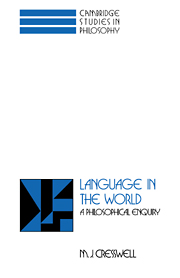Book contents
- Frontmatter
- Contents
- Preface
- Introduction
- 1 A simple formal language
- 2 Predicates and functors
- 3 The isomorphism problem
- 4 Quantification
- 5 Transmundism
- 6 Putnam's ‘Meaning of “meaning”’
- 7 Lewis on languages and language
- 8 Causation and semantics
- 9 Belief–desire psychology
- 10 Direct knowledge
- References
- Index
2 - Predicates and functors
Published online by Cambridge University Press: 01 October 2009
- Frontmatter
- Contents
- Preface
- Introduction
- 1 A simple formal language
- 2 Predicates and functors
- 3 The isomorphism problem
- 4 Quantification
- 5 Transmundism
- 6 Putnam's ‘Meaning of “meaning”’
- 7 Lewis on languages and language
- 8 Causation and semantics
- 9 Belief–desire psychology
- 10 Direct knowledge
- References
- Index
Summary
Meanings of whole sentences of ℒ are sets of worlds. Actually this isn't quite right since a sentence like (6) on page 6 could be true at one time and false at another. We must pretend that all the sentences of our restricted little language ℒ are understood as referring to some particular time. But whole sentences are complex expressions, and according to Frege's Principle, their meanings depend on the meanings of the symbols in them, together with the rules for combining those meanings. It is here that the categorial description of the syntax of ℒ becomes relevant. Consider the one-place predicates of ℒ. They are runs and whistles. In a categorial description one-place predicates turn a name into a sentence. Now among the set of all possible worlds there will be those in which (at the particular time that we are assuming ℒ to be talking about) Adriane is running. Call this set p. There will also be the set of worlds in which Bruce is running. Call this set q. At this point we have to remember that worlds, whatever they are, are not linguistic things. That Adriane is running in a world, or that Bruce is running in a world, is something which in some sense is ‘out there’ and which can be referred to in ℒ.
- Type
- Chapter
- Information
- Language in the WorldA Philosophical Enquiry, pp. 20 - 33Publisher: Cambridge University PressPrint publication year: 1994

